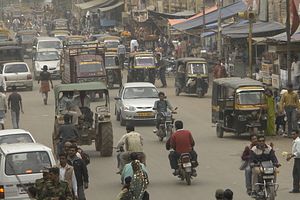South Asian countries need to do more to facilitate the movement of goods and services with each other and other regions. Regulatory and legal schemes make it the least economically integrated region in the world, despite the technological feasibility of infrastructure and cultural connections between the region’s states. There is thus a danger that the region’s countries will individually become integrated into the greater Asian economy through a third country, namely China, a trend that is underscored by Xi Jinping’s recent trip to Pakistan. While this is not bad for individual countries, it will hurt the region as a whole.
One way that South Asian countries thwart each other is by using their geography to make land trade for other states all the more convoluted, driving up costs and generally making trade needlessly more difficult for their neighbors.
India and Pakistan, for example, are interested in trading with Afghanistan and Tajikistan, respectively, countries that they do not border. In theory, this should be relatively easy. During the Mughal Empire, a road, the Grand Trunk Road was built between Kabul and Chittagong through Delhi, running through modern-day Afghanistan, Pakistan, India, and Bangladesh. The road still exists and many sections of it have been converted into modern highways. In addition, multiple other roads and railways connect the region, so the possibility of physical trade is not hindered by foreboding terrain that prevents the construction of infrastructure. Rather, modern borders come in the way.
For example, Pakistan is blocked from having a direct land route with Central Asia because of Afghanistan. During the British Raj, the Wakhan Corridor of Afghanistan was specifically designed to keep the British and Russian empires from touching, and thus modern-day Pakistan and Tajikistan do not share a border. Afghanistan’s President Ashraf Ghani brought up this point during his recent visit to India, arguing that Afghanistan could facilitate Pakistani connectivity to Tajikistan if Pakistan facilitated Indian connectivity to Afghanistan. Ghani aimed to facilitate connectivity between Afghanistan, Pakistan, and India, and then on to Central Asia.
However, this is something that Pakistan has continued to block. Since the Partition, Pakistan has prevented Indian access to Afghanistan, by not giving India any transit rights to access the Afghan market for its exports. However, to maintain good relations with Afghanistan, Pakistan offered transit rights to Afghanistan’s exports to India in 1948. Nonetheless, landlocked Afghanistan is hardly happy with this situation, as it essentially forces it to depend on Pakistan (and to a lesser extent, Iran) for the import of the majority of its goods from the outside world.
India, for its own part, does not allow Pakistan land access to Nepal, Bhutan, and Bangladesh through its territory. This has hurt Pakistan’s ability to meaningfully exchange goods with most of the rest of South Asia. Ironically, there is limited land trade between India and Pakistan, mostly restricted to a specific list of goods. The one bright spot in regional transportation links is India’s open border with Nepal.
As for Afghanistan and Central Asia, to circumvent Pakistan, India has invested in developing links with Iran, a state that India has sea links with. Pakistan again sits in the way via land and it does not itself have good transportation or trade links with Iran, though a gas pipeline may be built soon. Because of China’s investment in Pakistan’s infrastructure and the possibility of sanctions on Iran being lifted soon, India is now pushing ahead with its plan to develop the eastern Iranian port of Chabahar and built a road from Chabahar to the border with Afghanistan; it has already built a road from Zaranj, Afghanistan on the southwestern border with Iran, further inland toward central Afghanistan in Nimruz province. Yet Afghanistan already has lively trade links to Iran through the northwestern city of Herat and more importantly, the Chabahar project has repeatedly stalled over the course of the past decade and it is unclear if and when it will be finished. Chabahar can only be a good thing for all the countries involved and ought to go ahead but only as a complement to other, more direct, already established routes between eastern Afghanistan and India.
The underlying strategic and military rivalry between Pakistan and India — the root cause of the connectivity issues for the region — are unlikely to be solved anytime soon. However, it would be beneficial for everyone in South Asia and Central Asia if strategic conflicts were simply disassociated with trade issues as much as possible, as in the example of China’s trade with Taiwan and Japan. In a scenario where geography is allowed to facilitate rather than hinder connectivity, both India and Pakistan would benefit immensely due to easy access to new markets, outweighing any loss; Pakistan especially so since it borders three of the world’s 20 largest economies in China, India, and Iran.

































